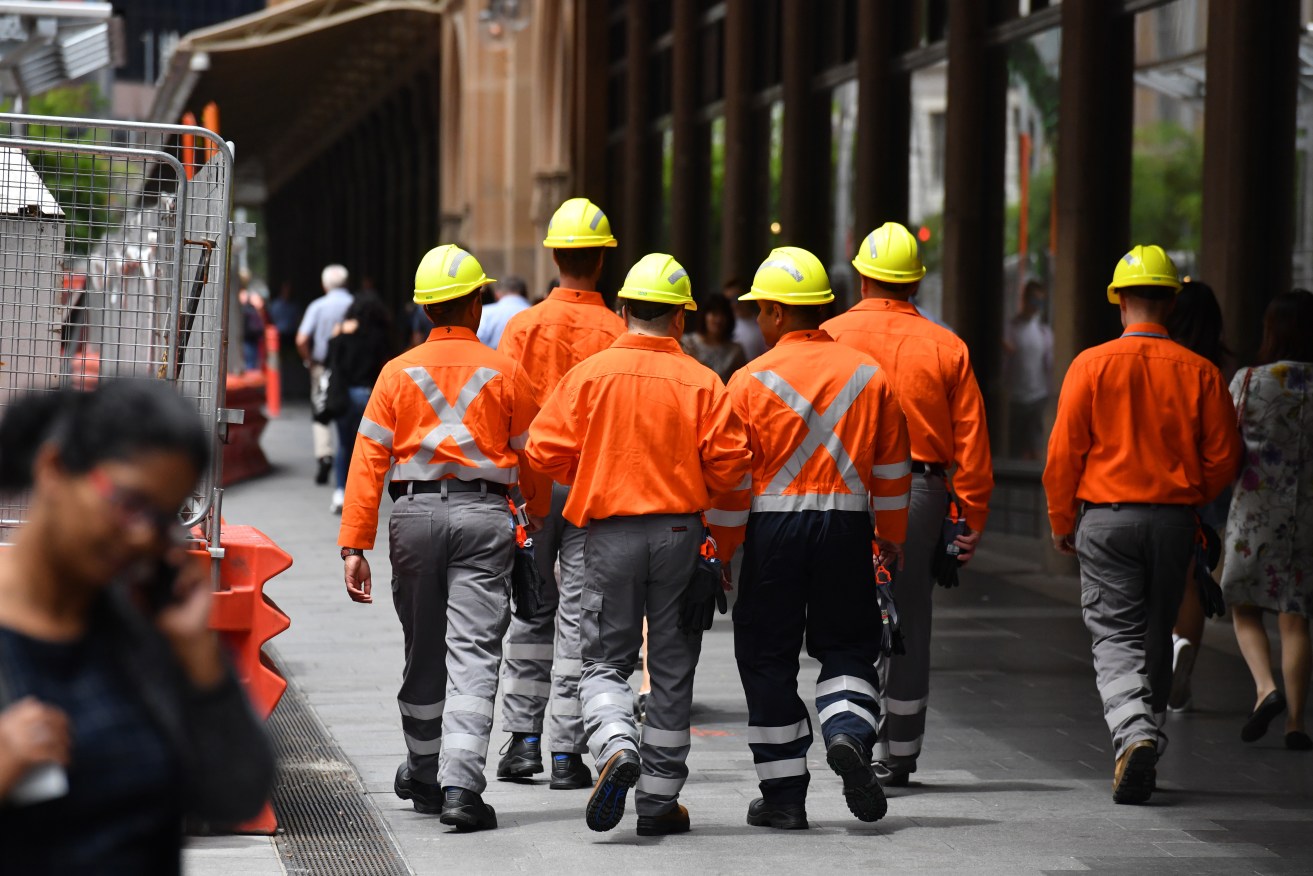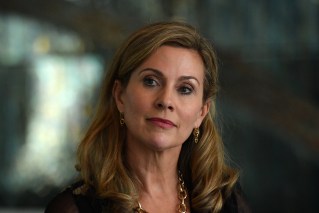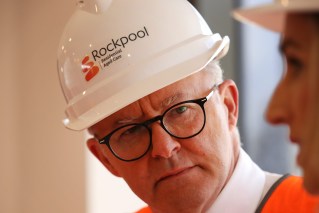Mind the gap: Many of our biggest companies admit to role in women’s pay injustice
Some of Australia’s biggest companies have had their dirty laundry aired as gender wage gap data from thousands of organisations is made public for the first time.

Construction site workers and office workers are seen at lunch break in Sydney, Wednesday, December 12, 2018. (AAP Image/Mick Tsikas)
The data, published by the Workplace Gender Equality Agency, has been broken down by industry into base salaries and total pay including superannuation, overtime and bonuses.
It shows 90 per cent or more employers in the mining, electricity, water and waste services and financial and insurance services industries have a gender pay gap favouring men.
More than 80 per cent of those employers have a gap above 9.1 per cent. The national average is 21.7 per cent, equivalent to women earning $26,393 less than men annually.
There is also a link between more women in leadership roles and lower pay discrepancies, while employers with gender balance in management roles were 50 per cent more likely to have a neutral pay gap.
Federal Minister for Women Katy Gallagher says the publication of this data would incentivise businesses to improve.
“We’re not pretending that there’s an easy solution … It’s been around for a long time and we need to make sure that we’re doing what we can to drive better outcomes,” she told ABC radio on Tuesday.
“I think it will drive improved performance.
“It’s not about naming and shaming… that isn’t the intention behind this, this is about transparency, accountability.”
Australian airlines including Qantas, Jetstar and Virgin reported a median pay gap of 37 per cent, 43.7 per cent and 41.7 per cent respectively.
Qantas Group chief people officer Catherine Walsh said the data did not mean women were paid less than men to do the same jobs.
Rather there was significant under-representation of women in more highly paid roles such as pilots and engineers, jobs the airline was working to encourage more women into.
“The years of training required for these roles means improving the gender balance of these work groups will take time,” Ms Walsh said.
Banks also reported significant pay gaps in favour of men, including 18.8 per cent at NAB, 28.5 per cent at Westpac and 29.9 per cent at the Commonwealth Bank.
A CBA spokesperson said women reflected 54 per cent of the bank’s local workforce and 44 per cent of leadership roles.
But 71 per cent of customer service and operational roles, which typically have lower rates of pay, were held by women.
“CBA’s median pay gap reflects many factors influencing the gender pay gap more broadly, including the types of roles performed by women, the seniority of those roles and the composition of the workforce,” the spokesperson said.
Gender equality agency chief executive Mary Wooldridge said the data release, made possible by a legislative reform passed in 2023, was a significant step forward in understanding gender equality in Australian workplaces.
“Transparency and accountability is actually beneficial to employees, to the community and to the nation as a whole because gender equality is beneficial on all of those levels,” she said.
“(Pay gap reporting) is something that’s happened in other countries with very positive outcomes, and it’s a useful step in the journey to equality.”
While there was no legal requirement for organisations to reduce pay gaps in their organisation, Ms Wooldridge said employers who failed to act on the data would be disadvantaged.
Deputy Opposition Leader Sussan Ley welcomed the data as information that “makes clear who is getting this right and who is getting this wrong”.
“There are big name brands who make profits off the products they market to women while not meeting gender pay parity in their own workforces,” she said.
“That is unacceptable.
“To those organisations and businesses who have failed to meet the mark, you have been put on notice.”
GENDER PAY GAP – KEY POINTS
* Private-sector employers with 100 or more workers have had their median gender pay gaps published by the Workplace Gender Equality Agency
* The release includes all employee salaries other than CEOs, heads of business, casual managers, furloughed employees and those who report as non-binary
* The data has been calculated for both the median base salaries and total pay which includes superannuation, overtime and bonuses
* The release includes pay gaps favouring both women and men
* The agency considers pay gaps within the plus or minus five per cent range to be neutral, meaning they do not favour either gender
MAIN POINTS
* Of the nearly 5000 employers included in the data release, half have a median employer gender pay gap lower than 9.1 per cent and half have a gender pay gap higher than 9.1 per cent
* Gender pay gaps differ widely across industry types
* Workplaces with 5000 or more employees in male-dominated industries have the largest gender pay gaps
* Employees in female-dominated industries are the most likely to work for an employer with a neutral gender pay gap
* Of employers in female-dominated industries, 44 per cent have a neutral gender pay gap, compared to 30 per cent in mixed-gender industries and 18 per cent in male-dominated industries
* There is also a clear link between more women in leadership and a lower gender pay gap
EMPLOYER RESPONSES
* “We’re expanding our outreach into high schools to promote aviation as a career which hopefully results in more girls choosing subjects that put them on track to become pilots and engineers of the future.” – Qantas Group chief people officer Catherine Walsh
* “Our focus is on improving the gender pay gap by increasing participation of women in senior roles as well as specialist areas such as institutional banking and technology. We’re proud to have 49 per cent women in our senior leadership positions, but we recognise there is more work to do.” – Westpac spokesperson
* “We made solid progress towards NAB’s gender representation targets and pay equity in 2023, but acknowledge there is more work to do. NAB has an ongoing focus on pay equity and driving greater representation of women in leadership roles across all areas of the bank.” – NAB Group Executive people and culture Sarah White
* “As part of our ongoing and demonstrated commitment to close the gender pay gap, we have, and will continue to, play our part to improve gender equality outcomes. This includes goals to increase the proportion of women in both more senior roles and higher paying roles.” – CBA spokesperson












